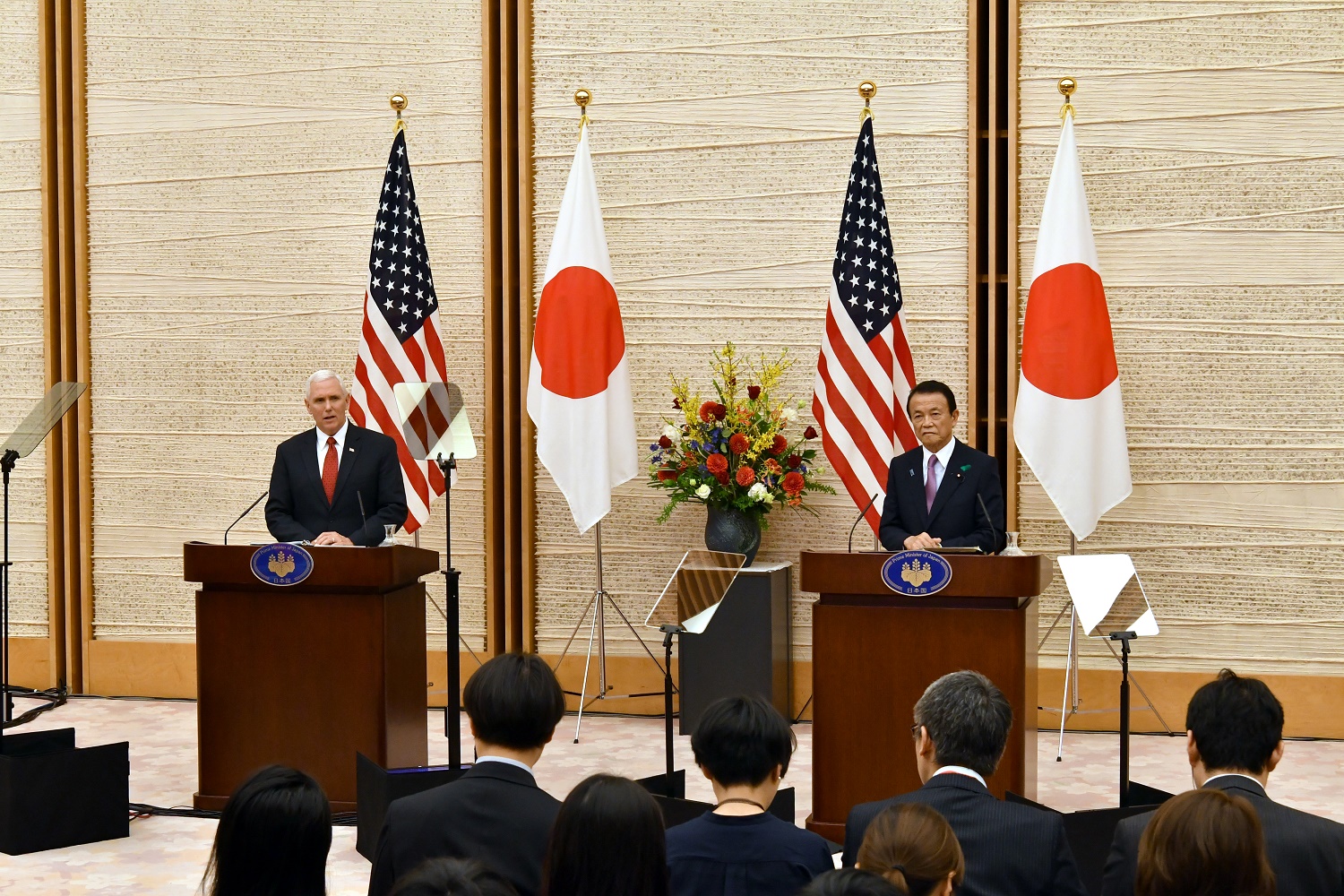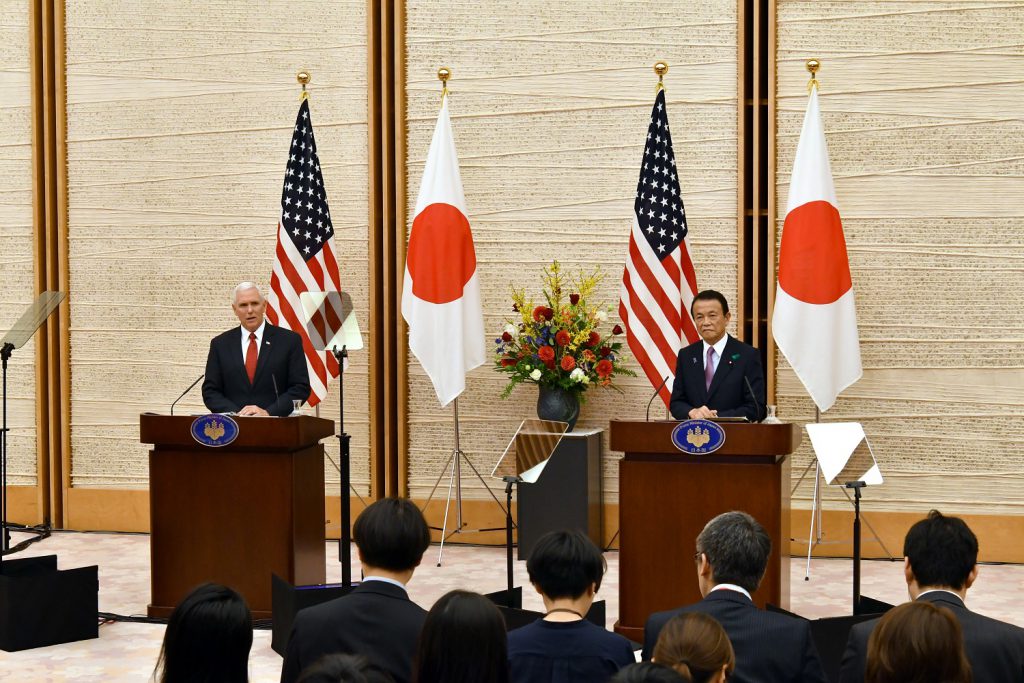Response to Japan-U.S. Economic Dialogue: Create Rules to Promote Free Trade
Asahi: Japan must keep pressing U.S. on protecting free trade principles
Sankei: Keep working to prevent protectionism
Nikkei: Economic dialogue should encourage structural reforms in both Japan and U.S.
Mainichi: Japan-U.S. trade talks should be mutually beneficial
Yomiuri: Japan, U.S. must pursue mutual benefits through economic dialogue

Photo: Natsuki Sakai/AFLO
Japanese Deputy Prime Minister and Minister of Finance Taro Aso met with American Vice President Mike Pence on April 18 for an economic dialogue, in which they decided to proceed with talks about trade and investment rules, collaboration on economic policies, and cooperation in infrastructure and energy development. This first economic dialogue only went as far as agreeing on an overall framework for negotiations, with details left to be decided in future discussions, but Pence showed strong interest in negotiating a Japan-U.S. free-trade agreement based on President Trump’s “America First” policy.
The five Japanese national dailies covered this topic in their editorials on April 19, welcoming the creation of a framework for negotiations while calling for both Japan and the U.S. to reject protectionism and carry out discussions on structural reform to further expand free trade.
■ Concerns Over Bilateral FTA With U.S.
The Asahi, stating that there is “a deep gap on trade issues” between Japan and the U.S., commented on the Trump administration’s stance of prioritizing American interests in bilateral negotiations: “…protectionism is not a good idea. Japan’s top priority is to insist that the United States abide by this fundamental principle.” In particular, the paper argued that if the American government was going to call for numerical targets in trade negotiations, as it did in the 1980s, then “Japan must first call out the United States on this,” stating that trade policy does not determine trade balances, and that “Having a trade surplus or deficit has nothing to do with ‘winning’ or ‘losing.’”
The Nikkei suggested that if Japan agrees to negotiations on a bilateral free-trade agreement, which Pence indicated interest in at a press conference, then “negotiations should be carried out based on agreements reached during negotiations for the Trans-Pacific Partnership (TPP).” The daily also argued that the economic dialogue as a whole relied on “whether discussions can focus not just on earning points in the short-term, but on carrying out structural reforms truly needed by both countries.”
The Mainichi, regarding Pence’s comments about a FTA, noted concerns that the U.S. “could press for unilateral market liberalization,” and that “The Trump administration…could make demands that give the United States an advantage.” The paper emphasized, “Japan should not comply with bilateral trade negotiations that would harm its national interests.” With the U.S. showing a strong interest in auto tariffs, the paper also noted “it is the United States that imposes a duty on vehicle imports — Japan has already eliminated this tariff.” Similarly, regarding the liberalization of the agriculture market, the paper pointed out that “Japan did in fact agree to reduce tariffs under the TPP. It was the Trump administration that unilaterally pulled out of the TPP.”
The Yomiuri, stating that economic dialogue should be based on a “perspective of mutual benefit,” praised Aso’s comment at a press conference that the relationship between Japan and the U.S. had turned “from friction to cooperation.” The paper did so because Aso’s statement took into account the fact that the U.S. had withdrawn from the TPP, and “put forth an idea of promoting free and fair trade rules in the Asia-Pacific region with the initiative taken by Japan and the United States.” The paper also noted that the times had changed since there was a significant U.S. deficit in Japan-U.S. trade, and that “Japan’s investments in the United States have created many jobs.” The Yomiuri flatly stated that Trump’s protectionist stance “can hardly be said to reflect the real situation.”
The Sankei, while emphasizing that the Japan-U.S. economic dialogue “should demonstrate the strength of the Japan-U.S. relationship to the world while working towards creating rules that will be a model for the world,” also argued that strengthening relations between Japan and the U.S., which are both economically liberally, “will help keep in check China’s push towards a military and economic hegemony.” However, stating that “Japan should not respond immediately” to a FTA, the Sankei declared, “If the U.S. wants to benefit more than it would from the TPP, that’s just selfish. Any unreasonable demands must be refused.”
■ Continue Negotiations for TPP Without U.S.
There was strong criticism of the Trump administration’s unilateral decision to withdraw from the TPP, negotiated between 12 countries. The Mainichi argued that instead of bilateral negotiations, the Japanese government should “persevere in calling for the U.S. to return to the TPP, which would contribute to growth in the Asia-Pacific region as a whole.” Following up by stating, “Japan should search for a path that avoids being brought in line with the pace of the Trump administration,” the Mainichi ended by hinting at the possibility of the TPP taking force without the U.S.
The Nikkei also argued that a “perspective to carry out mid- to long-term structural reform” that benefits both Japan and the U.S. was necessary, that bilateral negotiations should be based on agreements made for the TPP, and that “It is necessary to look for a way to put the TPP into effect with the 11 countries remaining in it, and not let it fall apart with the U.S.’s withdrawal.”
The Sankei also called for continued efforts to convince the American government of the strategic value the TPP was meant to have, and argued, “In parallel with the Japan-U.S. dialogue, the other countries involved in the TPP should carefully consider putting it into effect even without the U.S.” The reasoning for this is that the TPP agreements in the areas of trade and investment are the “basic goal,” with difficult negotiations leading to many pioneering elements in the TPP rules for the protection of intellectual property. The paper noted, “It is important to create a route to allow the U.S. to join the TPP in the future.”
The Asahi, noting that the global economy is connected by industrial supply chains involving multiple countries, cautioned that a focus on bilateralism could sever these supply chains, indicating hope for further TPP negotiations while asking, “What should be done to get America the superpower to switch its focus from bilateral negotiations to multilateral frameworks?”
*English translations of The Yomiuri, The Asahi and The Mainichi are from The Japan News, The Asia & Japan Watch and The Mainichi, respectively. Those for The Nikkei and The Sankei are provisional. The content of this page was made by the Foreign Press Center Japan and does not reflect the opinion of the Japanese Government or any other organization.



